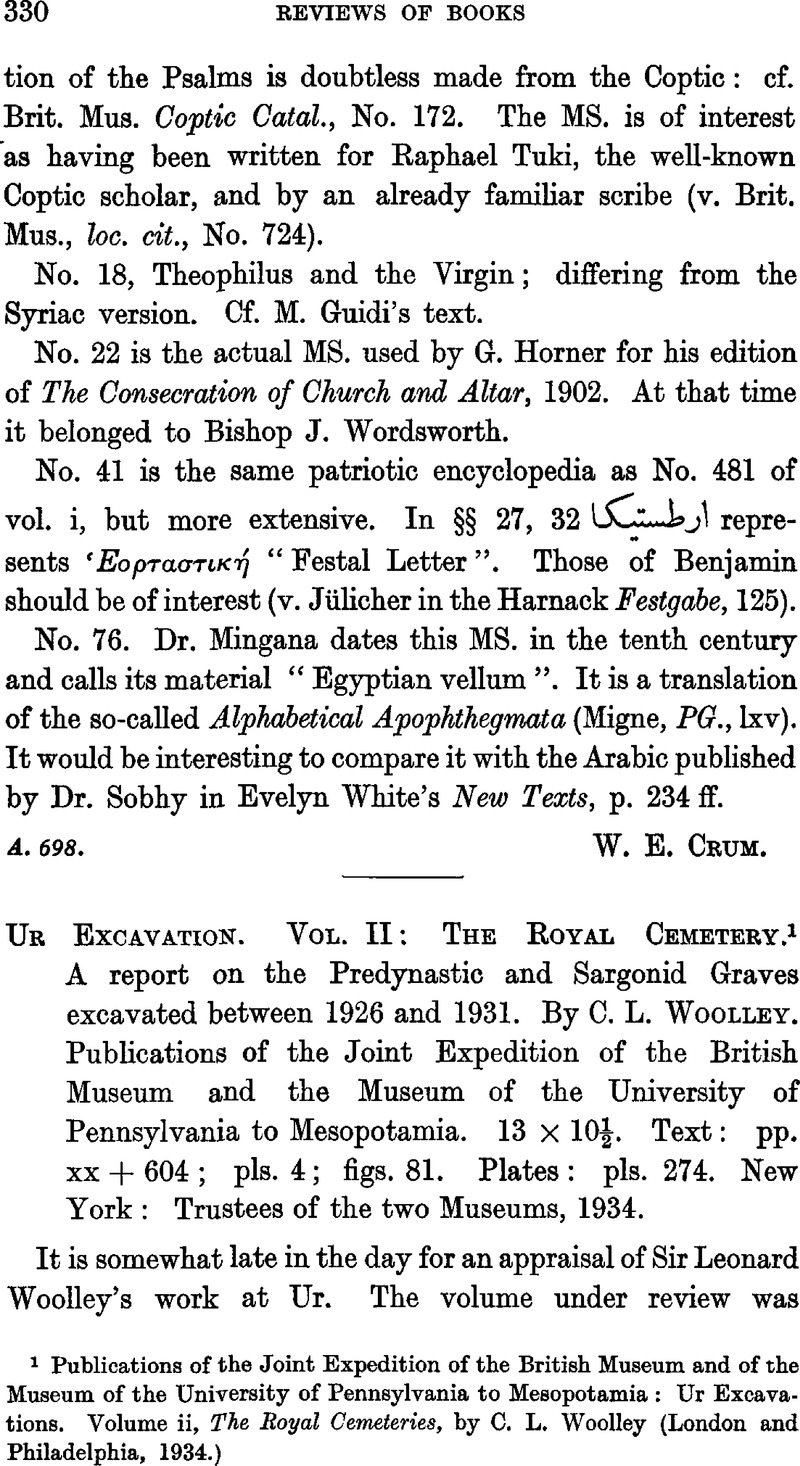No CrossRef data available.
Article contents
Ur Excavation. Vol. II: The Royal Cemetery. A report on the Predynastic and Sargonid Graves excavated between 1926 and 1931. By C. L. Woolley. Publications of the Joint Expedition of the British Museum andthe Museum of the University of Pennsylvania to Mesopotamia. 13 × 10½. Text: pp. xx + 604; pls. 4; figs. 81. Plates: pls. 274. New York: Trustees of the two Museums, 1934.
Published online by Cambridge University Press: 15 March 2011
Abstract

- Type
- Reviews of Books
- Information
- Copyright
- Copyright © The Royal Asiatic Society 1937
References
page 330 note 1 Publications of the Joint Expedition ofthe British Museum and of the Museum of the University of Pennsylvania to Mesopotamia: Ur Excavations. Volume ii, The Royal Cemeteries, by Woolley, C. L. (London and Philadelphia, 1934.)Google Scholar
page 332 note 1 For its interpretation see the seal, Weber, , Altorientalische Siegelbilder, 430Google Scholar.
page 333 note 1 p. 16, and Antiquaries Journal, viii, 420.
page 334 note 1 pp. 16–17, 215, 218–222. Also Antiquaries Journal, viii, 2–5, 419–420. It should also be remembered that the large tombs contained brick structures at various levels in their shafts, e.g. pp. 95 and 103, and that we have to reckon with superstructures of crude brick (Antiquaries Journal, viii, 4, 421–2), the decayed remains of which would be well-nigh indistinguishable from the brick-rubbish dumped in the “grey layer”.
page 335 note 1 Pl. 211, No. 286 (U–17656) alone is Early Dynastic, and No. 295 (U–17904) is no doubt intrusive since it belongs to the Third Dynasty of Ur, during which period much of the soil was worked through.
page 335 note 2 At Khafaje an Akkadian tablet was found in a house built of planoconvex bricks. See Oriental Institute Communications, No. 17, p. 68.
page 335 note 3 Mitteilungen der Deutschen Orient Gesellschaft, No. 73, p. 1.
page 335 note 4 Contenau, , Manuel, p. 673Google Scholar.
page 335 note 5 Delaporte, , Catalogue des Cylindres Orientaux (Louvre), pp. 11, 12Google Scholar.
page 335 note 6 The dating of cylinder seals will be discussed in two publications on that subject which are in preparation. See provisionally Oriental Institute Communications, No. 16, pp. 40–6.
page 336 note 1 Burrows, E., Archaic Texts (London, 1936)Google Scholar and Falkenstein, A., Archaische Texte aus Uruk (Berlin, 1936), p. 19Google Scholar.
page 336 note 2 Heinrich, E., Kleinfunde aus den Archaischen Tempelschichten in Uruk (Berlin, 1936), pp. 10, 32Google Scholar. See also Fifth Preliminary Report of the Iraq Expedition, Oriental Institute Communications, No. 20 (Chicago, 1936)Google Scholar.
page 338 note 1 Revue d'Assyriologie, vol. 31 (1934), pp. 173–189Google Scholar.
page 338 note 2 Ibid., pp. 137–143.
page 338 note 8 Oriental Institute Communications, No. 17, fig. 29.
page 339 note 1 See the comprehensive article by Scharff, in Zeitschrift für Aegyptische Sprache 71 (1935), pp. 89–106Google Scholar. Differences between our respective tables will be discussed elsewhere.
page 339 note 2 See Scharf, in Orientalistische Literatur Zeitung, 1928, 78 fF.Google Scholar, and also his Grundzüge der Aegyptische Vorgeschichte, pp. 46–58.
page 340 note 1 Gadd, , History of Monuments of Ur (London, 1929), 37 ffGoogle Scholar.
page 340 note 2 In Orientalistische Literatur Zeitung, 1931, 115 ff.
page 340 note 3 Moortgat, Anton: Frühe Bildkunst in Sumer (Mitteilungen der vorderasiatisch-Aegyptischen Gesellschaft, Band 40). Leipzig, 1935, pp. 6–23, 32Google Scholar.
page 340 note 4 The “Later Cemetery” at Al 'Ubaid which has been considered, reasonably enough, to be contemporaneous with the Temple of A-annipadda, is, in fact, much older. Its pottery is intimately linked with that of the graves of the First Early Dynastic Periodat Khafaje. See Fifth Preliminary Report of the Iraq Expedition, Oriental Institute Communications, No. 20 (Chicago, 1936)Google Scholar.
page 341 note 1 Gadd, , History and Monuments of Ur, p. 71 f.Google Scholar
page 341 note 2 I am aware that proper names of a similar form occur at Fara, but this excludes as little the possibility that “Meskalamdug” was the name of a part, as its possible translation “Hero of the Good Land (= Netherworld)” proves for certain that these men played the role of mock-king, as suggested here.
page 342 note 1 Smith, Sidney, “A Babylonian Fertility Cult,” in this Journal, 1928, pp. 849 ff.Google Scholar Also Böhl in Zeitschrift für Assyriologie, vol. 39.
page 342 note 2 See Iraq, i, p. 12, note 3. Sir Leonard Woolley's objections are vitiated by his not taking into account that the impersonator of the god need not be the king himself but the “Mock-king” whose existence in Mesopotamia is well testified by Berosus.
page 342 note 3 These will be discussed in the forthcoming publication of the Oriental Institute of Chicago University: Sculpture of the Third Millenium from Tell Asmar and Khafaje.
page 343 note 1 Langdon, , Epic of Creation, p. 49, line 66Google Scholar. The cylinder seals studied in Iraq, i, 2 ff., prove beyond a doubt that many if not all ritual features mentioned in late texts go back to immemorial antiquity.


